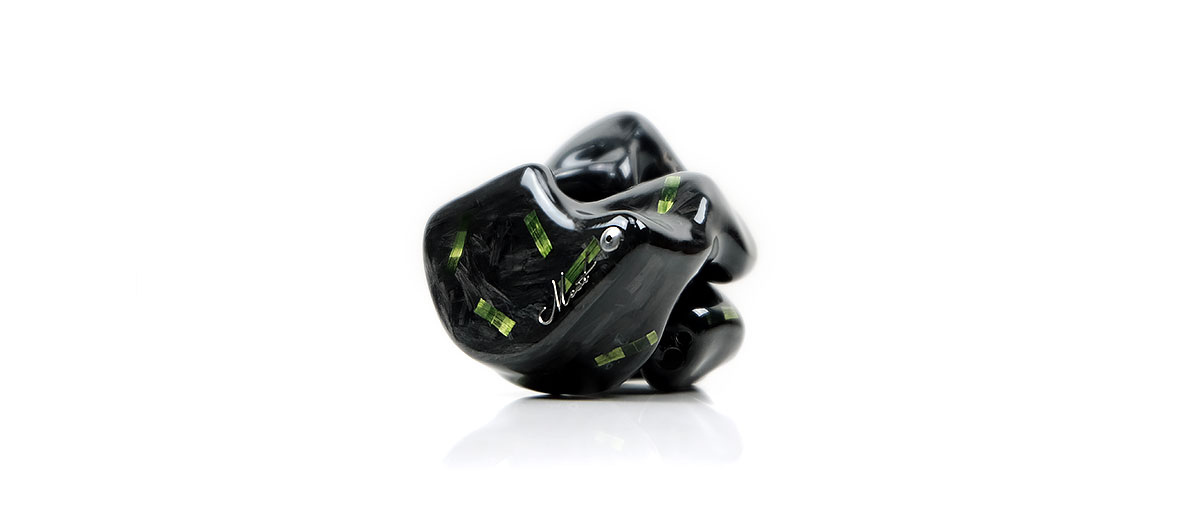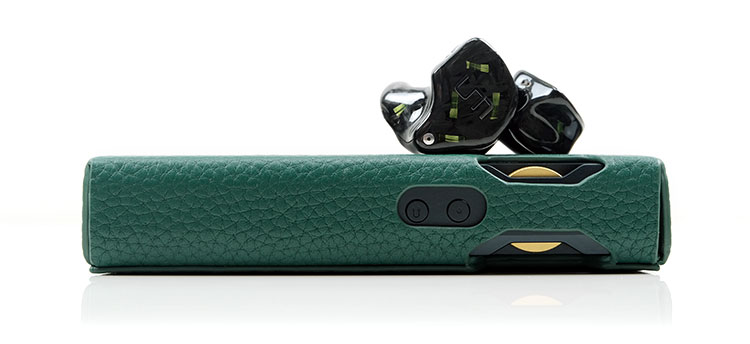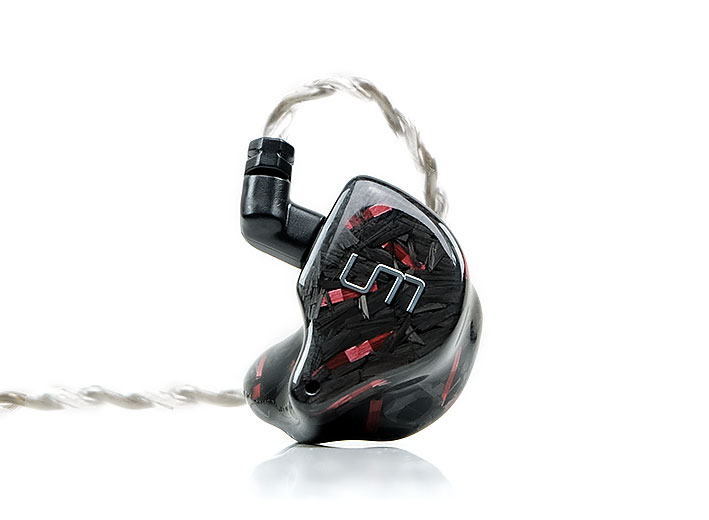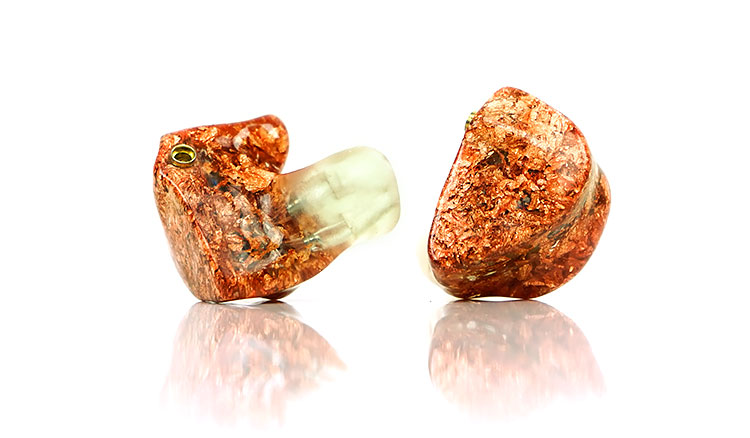Synergy
Efficiency
The MEST MKII is rated at 12.3Ω and 112dB SPL and is ever so slightly less efficient compared to the original which was 14Ω and 118dB SPL. Broadly speaking, the MEST MKII is sensitive but not overly sensitive and with performance levels slightly better than the MKI for higher noise floors.
For example, on the 4.4mm balanced output of the HiBy R8, we did report previously that the MKI as having small but detectable levels of background hiss. Paired with the MEST MKII, the noise floor or detectable hiss has been greatly reduced to the point where you will have to strain to hear it.
For current demands or volume levels, at the most, you will find around a 1-2dB difference between the original and the new MEST, (tested with Lotoo’s PW Gold Touch, 500mW @32Ω).
In fact, you could get away with no changing the volume at all in some instances though you might perceive the MKI to sound the livelier of the two at the same volume given its slightly brighter upper mids tuning.
Pairings
I did not actually come down in favor of any single fixed preference for pairings though you will not need more than a good quality DAP to drive the MEST MKII well. The rest of the pairing process is more down to synergy than technical. My triggers tended to be a good vocal presence and a strong bass definition with the MEST MKII pairings
For example, the LP P6 Pro was perhaps the most coherent for me in terms of harmonic balance and the one DAP that did the best out of all of our tested sources for bass and mids texture. Vocals were smooth as butter but still retained a very natural and detailed sound.
A close second to that was the DX300 albeit delivering a delta-sigma polished sound for texture and not quite as detailed but it did sound create a more expansive soundstage. AMP11 MKI does very well indeed for teasing out some additional vocal presence and can sound more focused compared to the P6 Pro in that regard.
The HiBy R8 introduces a bit more bass warmth and body but it is a soft billowy type of mid-bass and a slightly thinner upper mids and treble tone compared to both the DX300 and P6 Pro.
The PAW Gold Touch and FiiO M15 pushed out the MEST MKII vocal and treble energy a bit more for me. The M15 bass definition was excellent but the synergy felt a little on the thinner side in the mids and vocals whereas the Touch delivered a more robust and physical presence across the same range.
Select Comparisons
Unique Melody MEST MKI
$1699
Technical
Both the MEST MKI and MKII have the same internal driver types and configuration with a single 10mm dynamic driver for the lows, a dual BA driver unit for the mids and upper mids, dual BA for the highs, and dual Sonion electrostatic drivers for the ultra-highs.
The key change is the bone conductor driver in the MEST MKII which is now dBC-S Dual Sides Bone Conduction System and capable of a much broader response range from 500Hz up to 20K whereas the older driver in the MKI was really just the mids and highs.
The other visible change is the venting system which was a fairly non-descript opening on the front plate on MKI and is now a purpose-built steel vent for better venting and performance from the dynamic driver.
Specs have changed slightly with the MEST MKII marginally less sensitive at 112dB SPL from 118dB SPL though slightly less voltage required at 12.3Ω compared to 14Ω.
In truth, our real-world tests with the Lotoo PAW Gold Touch and LP P6 Pro didn’t pick out much of a driving or volume difference between either. However, the MEST MKII seems very marginally less sensitive to background hiss on outputs such as the HiBy R8 4.4mm. Not that it is high on the MEST, simply blacker on the MEST MKII.
Design
The MEST MKII is smaller and lighter than the original MEST with a slightly different range of carbon fiber and metal plate design color choices if you are going custom.
Also, the MEST MKII does away with that protruding 2-pin connector system and instead uses a 2-pin flat socket that sits flush with the shell. That further reduces the perception of size in favor of the MEST MKII. Some might have preferred the MKI’s connection stem’s better strength but most cable rollers will love the fact they can now swap cables on the MEST MKII.
But do you have to swap cables? The MEST MKII does come with a very good quality PW Audio creation under the UM M2 moniker that retails for over $500 on its own. It’s 4-wire compared to 26AWG 8-wire on the original granted, but the bigger 24AWG gauge in the M2 will render that higher MEST wire count moot for me.
Also, the finishing is snazzier on the M2 cable with a much cleaner profile and slightly lighter handling. Combined with the lack of protruding stems and lighter shell most will find the MEST MKII comfort levels a little higher. Both isolate as good as each other by the way and much better than you would think for a vented custom.
Performance
Though both monitor sound signatures are ‘playing in the same ballpark’, UM has tweaked the MEST MKII to sound a little smoother and more planted sounding than the original.
The MEST MKI relatively lighter sub-bass gets a big lift this time around with more mid-bass warmth resulting in a firmer bass response and better power from the MEST MKII’s dynamic driver.
The fundamental is stronger in lower-mids instrumental notes counteracting the BA mids and treble to produce a richer more liquid midrange timbre. In comparison, the MEST MKI mids are a bit drier and cleaner sounding with a lighter fundamental from the supporting dynamic driver.
You might perceive the MEST MKI vocals as a little further forward in the mix but they lack the same body and natural harmonic balance of the MEST MKII vocals. They do pick up a bit more treble influence in their timbre giving it that thinner tone if pitching high whereas the MEST MKII has the better treble to bass, warm to bright balance.
The custom MEST MKII treble is smoother than the universal but still slightly brighter than the MEST MKII treble. Not by a huge amount, but rather it sounds more coherent with a better upper-mids to treble transition. The nuanced difference is a softer overtone from the MEST MKII whereas the treble on the MKI can introduce a harder edge to notes.
In terms of staging, the MEST MKII casts a deeper and more powerful image than the original. You get a stronger perception of weight on the low-end and more power in the lower-pitching instruments. The MKI has a little bit more forwardness to its vocal imaging but not the same physical presence as the MEST MKII imaging.
Vision Ears VE7
€1650
Technical
We just reviewed the VE7 last Friday and given that it is at a relatively similar price point this might just be a viable competitor to the MEST MKII.
Whilst both have 7 ‘regular’ drivers, the internal configuration is a lot simpler on the VE7 with an all-BA design compared to the hybrid mix of dynamic, BA, and electrostatic on the MEST. Lest we not forget there is that additional dBC-S Dual Sides Bone Conduction System as another layer inside the MEST MKII
The configuration for the VE7 is 2 woofers for the lows, 2 for the lower mids, 1 full range for the mids, 1 for the mid-highs, and a tweeter for the super highs. All knitted together using a 5-way passive acoustic/electric crossover.
The MEST MKII is a single 10mm dynamic driver for the lows, a dual BA driver unit for the mids and upper mids, dual BA for the highs, and dual Sonion electrostatic drivers for the ultra-highs. The bone conduction layer is from 500Hzx to 20k and it also uses a 5-way crossover.
In terms of efficiency, the VE7 is rated at 12Ω impedance rating and 116dB SPL which is quite close on paper to the 12.3Ω and 112dB SPL of the MEST MKII.
In our real-world tests, the VE7 did show a higher degree of sensitivity in terms of volume compared to the MEST MKII but also a little more sensitive to hiss from the likes of the R8’s 4.4mm balanced output.
Design
Different design philosophies here but in terms of complexity the MEST MKII carbon fiber offers a bit more compared to the cleaner transparent purple aesthetic I used with the VE7. Mind you, there are a vast range of design choices with the VE7, more so than what UM offers for the MEST MKII, so this is not a straightforward comparison.
The form factor differences is a more concrete talking point with the MEST MKII offering a longer deeper nozzle compared to the VE7. The VE7 has a slightly more relaxed horn design fitting but the precision in the mold is so good you do not need that additional depth. Of the two, the VE7 isolation levels are even better due to the lack of venting on the front panel.
Both are very comfortable in the ear, there isn’t much of a size difference between the shells but the MEST MKII is the slightly heavier of the two drivers.
They do both use flat socket 0.78mm 2-pin connector systems so cable rolling is possible and I dare say almost mandatory on the VE7 as it uses a very lightweight but basic 4-wire high resistance copper cable whereas the MEST MKII’s 24AWG OCC copper M2 cable is by far the better performing and better-looking cable.
Performance
Very different presentations and technically quite different performers also. What hits you immediately is staging width with the VE7 casting out a wider but closer stereo image whereas the MEST MKII pulls it back a bit but adds more depth and height.
The MEST MKII is more holographic sounding stretching from front to back but not as intimate it is imaging, especially with vocals that are more relaxed in their positioning.
If you want power go with the MEST MKII’s stronger dynamic driver influenced sub-bass bias on the low-end. The VE7 has some excellent extension but it’s lighter in comparison to the density of the MEST MKII bass with its all-BA configuration for the low-end.
The decay is also shorter so it’s tighter, cleaner, and faster sounding on the VE7 but the bass fundamental is better on the MEST MKII. That does mean the VE7 mids are more in focus and you do get a lot more energy and vibrancy from the VE7 midrange whereas the MEST MKII dials it back a bit more in favor of a smoother and richer tone.
The MEST MKII will inject more body also into the mids timbre whereas the VE7 pulls from a beautifully pure sounding treble tuning to give it a much sweeter ethereal overtone for mids, especially upper mids and higher pitching vocals.
Despite the MEST MKII using electrostatic tweeters, the VE7 upper treble has more energy and presence. The VE7 elevates around 8-10k whereas the MEST MKII bias is to the lower to mid-treble energy so you get an airier pristine tone from the VE7 top-end.
Westone ES80
$1899
Technical
The Westone flagship Elite Series custom monitor is also an 8-driver implementation with a very similar price point to the MEST MKII. Inside, the ES80 uses an all-BA driver array with a dual driver for the lows, a dual driver for the mids, and a quad array for the highs using a 3-way crossover.
That’s a bit simpler than the MEST MKII’s single dynamic for the lows, a dual BA for the mids and upper mids, dual BA for the highs, and dual Sonion electrostatic drivers for the ultra-highs. Not to mention the additional bone conduction layer from 500Hz to 20k and a more complex 5-way crossover.
In terms of sensitivity, the ES80 has a very high impedance rating of 80Ω and a similar SPL to the MEST MKII at 111dB compared to 112dB. That is probably one of the more unusual custom monitor ratings out there.
You are going to need a lot more juice for the ES80 with our Lotoo Touch a good 15-18 steps higher in low gain SE compared to the MEST MKII. You can crank up the dial a lot more and the ES80 will very slowly take to that additional volume also.
Neither are prone to hiss with the ES80 even less so on higher noise floors such as the 4.4mm R8 output.
Design
In truth, the ES80 copper flake design here is one of my favorite custom monitor designs, at least in my top 5. It is not just the look but the feel in your hand that makes it very unique.
This is not a typical acrylic finish with a cold pouring and Flex material build that creates rougher texture in part with a misty hue so it is not quite transparent. It also feels a touch softer than the pure acrylic green carbon fiber finish of the MEST MKII.
The Flex Canal is also stated as a body temperature reactive material so it has mildly expansive properties when heated by your ear canal. The MEST MKII is more about nozzle depth for me to get that additional seal.
Both do isolate very well but the different materials create a different isolation performance. As an example with my 0.5hp window-type aircon, the ES80 beautifully blocks out the lower frequencies whereas the MEST MKII aims for the mid and high frequencies of the air con. You hear a little more rumble with the MEST MKII and you get more high-pitched noise with the ES80.
The ES80 uses an MMCX system with a decent $299 ALO Audio Reference 8 cable which is an 8-wire 26AWG split into 4 conductors of high purity SPC and 4 OCC copper conductors in a stiffer FEP jacket.
The UM M2 is the better cable though and it should be given it’s double the price. It is finished to a much higher spec, much less microphonic, handles better, and with a bigger 24AWG OCC copper gauge.
Performance
The ES80 is a more neutrally tuned and very coherent sounding monitor whereas the MEST MKII has a bit more bias on the low-end and sparkle on the top. Of the two, the ES80 is more reference and accurate whereas the MEST MKII is more musical, and more inclined to deliver a stronger PRaT.
With the ES80 you get more of a typical BA low-end with a lighter sub-bass presence, a stronger mid-bass hump but not a huge dip into the lower mids.
The MEST MKII is much more elevated with that weightier dynamic driver slam, better texture but a slower decay. Of the two, the MEST MKII is much more powerful whereas the ES80 relies a bit more on mid-punch for its rhythm.
Lower-mids instruments on the ES80 do not have too much energy sucked out of them, vocals have a nice clear tone and are more to the fore. There is a bit of a bump in the ES80 upper mids that flesh out female vocals better than male vocals. Timbral control is very consistent and coherent sounding throughout the mids and highs with its all-BA implementation.
MEST MKII mids have a bit more vibrancy and contrast to them as well as sounding more open and spacious. It has less of a reference quality with upper-mids vocals sitting further forward. The timbre in the upper mids whereas lower pitching instruments sound fatter, weightier, and warmer.
MEST MKII offers better upper treble extension from those electrostatic tweeters so staging is taller with more headroom. It also projects deeper and slightly wider. The ES80 instrumental separation is excellent with accurate placement but doesn’t have the same low-end reach or top-end sparkle.
Our Verdict
The Unique Melody MEST MKII is an excellent custom monitor with plenty of complex technology stuffed inside, a quality design, and some notable improvements externally such as the flat pocket 2-pin connectors and that solid cable upgrade with the M2.
The tonal tweaks are more of a shift to the left or right than a radical change so whilst still absolutely top-class it might now appeal to a different type of audiophile with its weightier tone, smoother rich timbre, and generally less fatiguing listening experience.
Personally, I find it more agreeable but others might still prefer the more pristine quality of the original. It is still a bloody good bargain though, perhaps one of the most versatile custom monitors out there for a wide range of tastes. The MKI proved that over the last year with its very positive community feedback and I see no reason why the MKII will not continue to prove otherwise.
Unique Melody MEST MKII Specifications
- Driver Counts: 7+1
- Sensitivity: @1KHz 112dB
- Frequency Response: 20Hz-70kHz
- Cable Sockets: 2-pin Flat
- Shells: One Piece Carbon Fiber + Gold Foil
- Crossover: 5-way Crossover
- Resistance: 12.3 ohm
- Cable: UM M2 24AWG Upper-Grade OCC Custom Cable







